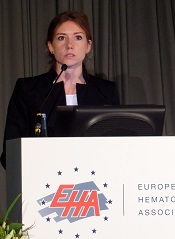
COPENHAGEN—Results of a new study suggest that vitamin K antagonists (VKAs) and non-VKA oral anticoagulants (NOACs) can both confer an increased risk of major bleeding, but the type of bleeding tends to differ with the type of anticoagulant.
The research showed that patients taking VKAs were more likely to be hospitalized for intracranial hemorrhage (ICH), while patients taking NOACs were more likely to be hospitalized for gastrointestinal (GI) bleeding.
In addition, the 30-day mortality rate was significantly lower in patients who were taking NOACs than in those who were taking VKAs. However, there was no significant difference between the 2 treatment groups when the researchers assessed mortality according to the type of major bleeding.
Laura Franco, MD, of the University of Perugia in Italy, presented these findings at the 21st Congress of the European Hematology Association (abstract S139*).
For this study, Dr Franco and her colleagues wanted to evaluate the real-life clinical presentation, management, and outcome of major bleeding in patients on anticoagulants.
So the team analyzed a cohort of patients treated at 9 Italian hospitals and a group of patients enrolled in Germany’s Dresden NOAC registry.
Between September 2013 and May 2016, there were 874 patients who were hospitalized for major bleeding—220 of whom who were taking NOACs and 654 of whom were taking VKAs.
Overall, 44% (n=386) of patients were hospitalized for an ICH, and 30% (n=261) were hospitalized for GI bleeding.
The incidence of ICH was 22% (n=48) among patients who received NOACs and 52% (n=338) among patients who received VKAs. The odds ratio was 0.26 (95% CI, 0.18-0.37; P<0.001).
The incidence of GI major bleeding was 46% (n=102) in the NOAC group and 24% (n=159) in the VKA group. The odds ratio was 2.69 (95% CI, 1.95-3.70; P<0.001).
The incidence of 30-day mortality was significantly higher in the VKA group than the NOAC group—17% and 10%, respectively. The adjusted hazard ratio (aHR) was 0.59 (95% CI, 0.36-0.94, P=0.012).
However, when the researchers looked at 30-day mortality according to the site of major bleeding, they observed no significant differences between the NOAC and VKA groups.
The incidence of 30-day mortality among patients with ICH was 25% in both the NOAC and VKA groups (aHR=1.07; 95% CI, 0.57-1.97). And the incidence of 30-day mortality among patients with GI bleeding was 7% in the NOAC group and 10% in the VKA group (aHR=0.66; 95% CI, 0.26-1.68).

*Data in the abstract differ from data presented at the meeting.

